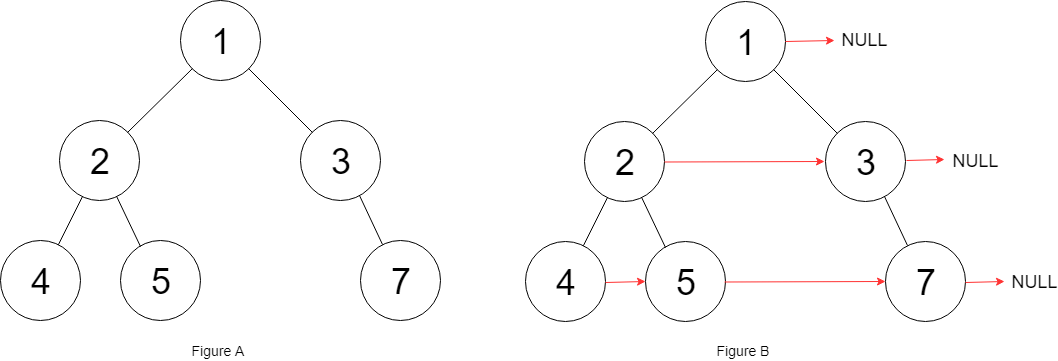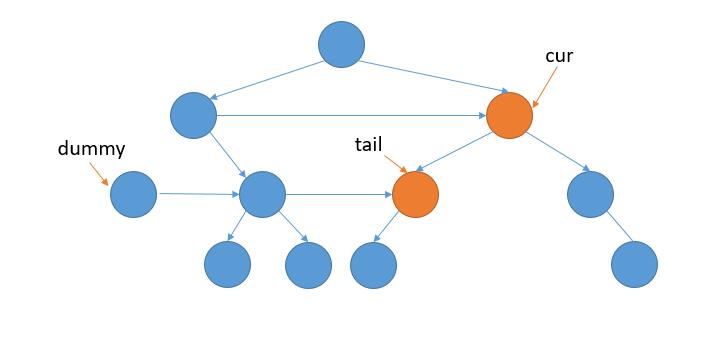友情支持
如果您觉得这个笔记对您有所帮助,看在D瓜哥码这么多字的辛苦上,请友情支持一下,D瓜哥感激不尽,😜
|
|
有些打赏的朋友希望可以加个好友,欢迎关注D 瓜哥的微信公众号,这样就可以通过公众号的回复直接给我发信息。

公众号的微信号是: jikerizhi。因为众所周知的原因,有时图片加载不出来。 如果图片加载不出来可以直接通过搜索微信号来查找我的公众号。 |
117. 填充每个节点的下一个右侧节点指针 II
给定一个二叉树:
struct Node {
int val;
Node left;
Node right;
Node *next;
}填充它的每个 next 指针,让这个指针指向其下一个右侧节点。如果找不到下一个右侧节点,则将 next 指针设置为 NULL 。
初始状态下,所有 next 指针都被设置为 NULL 。
示例 1:

输入:root = [1,2,3,4,5,null,7] 输出:[1,#,2,3,#,4,5,7,#] 解释:给定二叉树如图 A 所示,你的函数应该填充它的每个 next 指针,以指向其下一个右侧节点,如图 B 所示。序列化输出按层序遍历顺序(由 next 指针连接),'#' 表示每层的末尾。
示例 2:
输入:root = [] 输出:[]
提示:
-
树中的节点数在范围
[0, 6000]内 -
-100 <= Node.val <= 100
进阶:
-
你只能使用常量级额外空间。
-
使用递归解题也符合要求,本题中递归程序的隐式栈空间不计入额外空间复杂度。
思路分析
这道题和 116. Populating Next Right Pointers in Each Node 算是姊妹题。
最简单的方式,使用 Deque 来保存每一层节点,然后建立起来"连接"。但是,很明显,这种方案不符合空间复杂度要求。
基于上面这种解法,再深入思考一步,上面使用 Deque 就是想要保存接下来需要访问的元素,并且保存访问的前后顺序。现在 Node 上有 next 字段,可以利用这个字段,打通这条链表,遍历上一层时,打通下一次的链接结构。这里需要保存的就有两点:
-
这条链表的头结点,用于下一层的遍历;
-
这条链表的尾节点,用于添加下一个节点。
这道题的思路和 116. Populating Next Right Pointers in Each Node 思路几乎是一样的:在上层遍历中,建立下一层的链接。
但这道题和 116. Populating Next Right Pointers in Each Node 在于:116 是完全二叉树,那么可以直接使用 next 节点的 left 子节点。这道题不是一个完全二叉树,所以,就需要在运动中寻找不为空的节点。另外,最左节点的选择,也不能直接使用 mostLeft.left,也是需要在运动中去寻找下一层第一个不为空的节点。两道题区别不大只是需要多注意细节。

这样,把第一种解法的代码稍作修改就可以了。
看题解,别人大部分是用了两层循环,外层是负责向下推进,内层负责同层向右。D瓜哥用了一层循环来遍历每个节点。
-
一刷
-
二刷
-
二刷(优化)
-
三刷
1
2
3
4
5
6
7
8
9
10
11
12
13
14
15
16
17
18
19
20
21
22
23
24
25
26
27
28
29
30
31
32
33
34
35
36
37
38
39
40
41
42
43
44
45
46
47
48
49
50
51
52
53
54
55
56
57
58
59
60
61
62
63
64
65
66
67
68
69
70
71
72
73
74
75
76
77
78
79
80
81
/**
* @author D瓜哥 · https://www.diguage.com
* @since 2020-02-09 23:17
*/
static class Node {
public int val;
public Node left;
public Node right;
public Node next;
public Node(int x) {
this.val = x;
}
@Override
public String toString() {
return "Node{" +
"val=" + val +
", left=" + left +
", right=" + right +
'}';
}
}
/**
* Runtime: 1 ms, faster than 49.14% of Java online submissions for Populating Next Right Pointers in Each Node II.
* Memory Usage: 41.4 MB, less than 100.00% of Java online submissions for Populating Next Right Pointers in Each Node II.
*
* Copy from: https://leetcode-cn.com/problems/populating-next-right-pointers-in-each-node-ii/solution/xiang-xi-tong-su-de-si-lu-fen-xi-duo-jie-fa-by-28/[详细通俗的思路分析,多解法 - 填充每个节点的下一个右侧节点指针 II - 力扣(LeetCode)]
*/
public Node connect(Node root) {
Node curr = root;
while (Objects.nonNull(curr)) {
Node dummy = new Node(0);
Node tail = dummy;
while (Objects.nonNull(curr)) {
if (Objects.nonNull(curr.left)) {
tail.next = curr.left;
tail = tail.next;
}
if (Objects.nonNull(curr.right)) {
tail.next = curr.right;
tail = tail.next;
}
curr = curr.next;
}
curr = dummy.next;
}
return root;
}
/**
* Runtime: 1 ms, faster than 49.14% of Java online submissions for Populating Next Right Pointers in Each Node II.
* Memory Usage: 40.8 MB, less than 100.00% of Java online submissions for Populating Next Right Pointers in Each Node II.
*/
public Node connectDeque(Node root) {
if (Objects.isNull(root)) {
return null;
}
Deque<Node> deque = new LinkedList<>();
deque.addLast(root);
Node prev = null;
while (!deque.isEmpty()) {
int size = deque.size();
for (int i = 0; i < size; i++) {
Node curr = deque.removeFirst();
if (Objects.nonNull(curr.left)) {
deque.addLast(curr.left);
}
if (Objects.nonNull(curr.right)) {
deque.addLast(curr.right);
}
if (i > 0) {
prev.next = curr;
}
prev = curr;
}
}
return root;
}
1
2
3
4
5
6
7
8
9
10
11
12
13
14
15
16
17
18
19
20
21
22
23
24
25
26
27
28
29
/**
* @author D瓜哥 · https://www.diguage.com
* @since 2024-06-25 17:26:18
*/
public Node connect(Node root) {
if (root == null) {
return null;
}
Queue<Node> queue = new LinkedList<>();
queue.offer(root);
while (!queue.isEmpty()) {
int size = queue.size();
Node pre = null;
for (int i = 0; i < size; i++) {
Node cur = queue.poll();
if (pre != null) {
pre.next = cur;
}
if (cur.left != null) {
queue.offer(cur.left);
}
if (cur.right != null) {
queue.offer(cur.right);
}
pre = cur;
}
}
return root;
}
1
2
3
4
5
6
7
8
9
10
11
12
13
14
15
16
17
18
19
20
21
22
23
24
25
26
27
28
29
30
31
32
33
34
35
36
37
38
39
40
41
42
43
44
45
46
47
48
49
/**
* @author D瓜哥 · https://www.diguage.com
* @since 2024-06-25 17:26:18
*/
public Node connect(Node root) {
if (root == null) {
return null;
}
Node mostLeft = root;
while (mostLeft != null) {
Node cur = mostLeft;
mostLeft = null;
Node prev = null;
while (cur != null) {
if (cur.left != null) {
// 不能保证左子树的最节点就一定有值
// 所以,在运动中,寻找最左节点
if (mostLeft == null) {
mostLeft = cur.left;
}
// 由于不是完全二叉树,
// 所以需要在运动中寻找不为空的节点
if (prev != null) {
prev.next = cur.left;
prev = prev.next;
} else {
prev = cur.left;
}
}
if (cur.right != null) {
// 不能保证左子树的最节点就一定有值
// 所以,在运动中,寻找最左节点
if (mostLeft == null) {
mostLeft = cur.right;
}
// 由于不是完全二叉树,
// 所以需要在运动中寻找不为空的节点
if (prev != null) {
prev.next = cur.right;
prev = prev.next;
} else {
prev = cur.right;
}
}
cur = cur.next;
}
}
return root;
}
1
2
3
4
5
6
7
8
9
10
11
12
13
14
15
16
17
18
19
20
21
22
23
24
25
26
27
28
29
30
31
32
33
34
35
36
37
38
39
40
41
42
43
44
45
46
47
48
49
50
/**
* @author D瓜哥 · https://www.diguage.com
* @since 2025-06-04 21:38:37
*/
public Node connect(Node root) {
if (root == null) {
return root;
}
Node cur = root;
Node mostLeft = root;
Node prev = null;
while (cur != null) {
// 寻找下一层最左节点
if (cur == mostLeft || mostLeft == null) {
mostLeft = cur.left;
if (mostLeft == null) {
mostLeft = cur.right;
}
}
if (prev != null) {
if (cur.left != null) {
prev.next = cur.left;
prev = prev.next;
}
if (cur.right != null) {
prev.next = cur.right;
prev = prev.next;
}
} else {
if (cur.left != null) {
prev = cur.left;
}
if (cur.right != null) {
if (prev != null) {
prev.next = cur.right;
prev = prev.next;
} else {
prev = cur.right;
}
}
}
if (cur.next != null) {
cur = cur.next;
} else {
cur = mostLeft;
prev = null;
}
}
return root;
}

